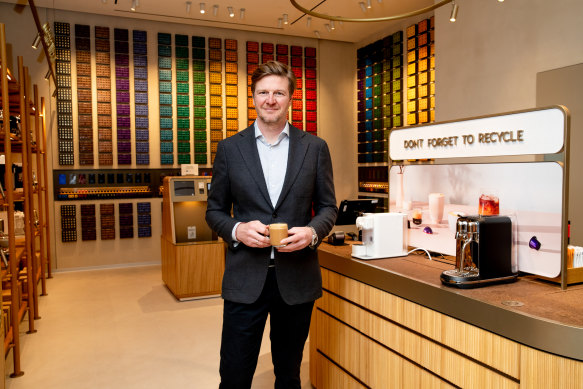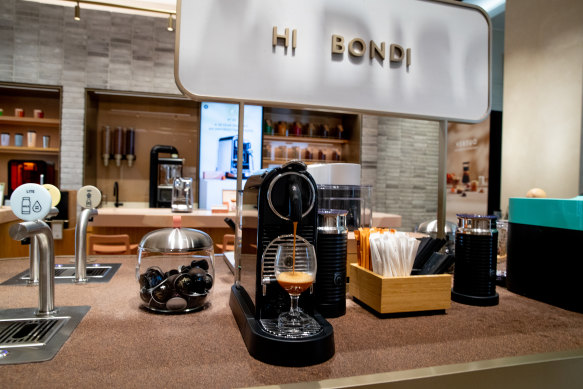By Jessica Yun
Nespresso’s famous pods, first developed in 1988, are manufactured in Switzerland and then shipped to 81 countries around the world. But when it comes to brewing fresh ideas and new technology, the maestros of capsule coffee often take their cues from Down Under.
“We bring innovation from the market to the head office because they realise and recognise that a lot of trends start here in Australia,” says Nespresso Oceania managing director Stefan Vermeulen.

Nespresso Oceania’s new managing director Stefan Vermeulen.Credit: Edwina Pickles
He points to a framed visual of the Creatista machine, which along with the Vertuo machine was conceived in Australia, a top 10 revenue-driving market for Nespresso. “This is one of our best-selling machines across the world.”
Vermeulen has recently relocated to Sydney to step into his new role as head of the company’s Australia and New Zealand markets. A Belgian national, the managing director started with Nestle-owned brand in 2011 as an account manager and then climbed the ranks to do a 4.5 year stint as the head of Nespresso Professional Australia, the corporate office, food service and hospitality arm of the business, before leading NZ operations for 3.5 years.
As regional managing director, Vermeulen will focus on defending Nespresso’s position as the market incumbent and protecting its brand as a high-quality premium coffee capsule, particularly as economic pressures, such as mounting interest rates and higher grocery prices, bite into household budgets.
“I think, moving forward, portioned coffee is really the system that’s going to prevail,” he says.
“In an environment of cost of living [pressures], to provide a solution that brings a … no-barista-required experience in your home, this is not only in terms of quality the best way to do it but also a sustainable way to do it because of its precision consumption design.”
But competition in the coffee space is fierce: Vermeulen is conscious there is no shortage of ways to consume coffee at home, something that 67 per cent of Australians do. Instant, ground, roasted whole beans, filter coffee, cold brew, and ready-to-drink coffees such as Dare all vie for consumer dollars that are increasingly being carefully counted and driving customers towards more affordable private-label brands.
Within the capsule sector alone, Nepresso faces competition from myriad brands including Campos, Vittoria, L’Or, and Lavazza, which have released their own Nespresso machine-compatible pods and are widely accessible on supermarket shelves.
Nespresso’s direct-to-consumer business model means their capsules are not sold through department stores, supermarkets or retailers, and must be purchased online or in a Nespresso store. This strategy is seen as an advantage. “We have a super loyal fan base that know what we stand for.”
Despite cost of living pressures and its premium pricing, Nespresso has not yet seen a decline in sales, with Vermeulen noting that consumers may choose move between different methods of coffee consumption.
“It’s a very, very dynamic category,” he says. “It’s up to us to recognise that and understand the consumer and make sure that we’re there when they need us.
“We are obsessed by driving value. For some people, that’s convenience; for some people, that’s high-quality; for some people, that’s price. But I think we balance those things out so that we cater to most types of consumers.”
Brewing customer loyalty
A key strategy that the 37-year-old brand is using to capture customers is to double down on the brand experience, including revamping the feel of its retail stores. Nespresso has 20 stores around Australia, most which are based in capital cities, and last Thursday opened a new retail store in Bondi Westfield aimed at boosting engagement with its range of coffee pod machines.
“Our first generation of stores was more around transaction, while this is more around experience,” Vermeulen says.

Nespresso has opened a new retail store in Bondi Westfield.Credit: Edwina Pickles
Nespresso is also at pains to flog its sustainability credentials as a point of difference to shoppers. The Nestle-owned brand sources its coffee from 150,000 growers through a program co-developed with the Rainforest Alliance which encourages growers to adopt sustainable farming practices. In 2018, it struck a deal with Rio Tinto to manufacture coffee capsules using “responsibly sourced” aluminium.
“When we buy green coffee, we pay a premium to those farmers. It’s about 20, 30 per cent on average, which is significant,” Vermeulen says.
Nespresso Australia has also been a certified B Corporation since 2022. However, this has been met with criticism from non-profit and fair trade advocacy group Fair World Project, which spearheaded an open letter to B Lab Global last year calling for stronger certification requirements, pointing to reports that found children as young as eight were picking coffee on Guatemalan farms that supplied coffee to Starbucks and Nespresso, as well as increased working hours, chronic understaffing and exhaustion at its Swiss production factories.
Global coffee prices rose after Brazil, which produces roughly a third of the world’s bean supply, endured a drought followed by extreme frost in 2021. Nespresso has absorbed higher input costs such as energy, fuel and packaging.
“Obviously retail space, delivery services, transport [costs] et cetera goes up significantly, but we don’t want to pass it on to the consumer. We want to make sure that we deliver value, we deliver the right experience, we bring innovation, but against the fair price,” says Vermeulen.
Parent company Nestle raked in $162.4 billion in 2022. The Nespresso business contributed $11.2 billion.
The Business Briefing newsletter delivers major stories, exclusive coverage and expert opinion. Sign up to get it every weekday morning.